Low-Cost Roofwater System For Agricultural Supply
By Brock Dolman and Kate Lundquist
Photographs by Brock Dolman and Jim Coleman
Table of Contents
Acknowledgements
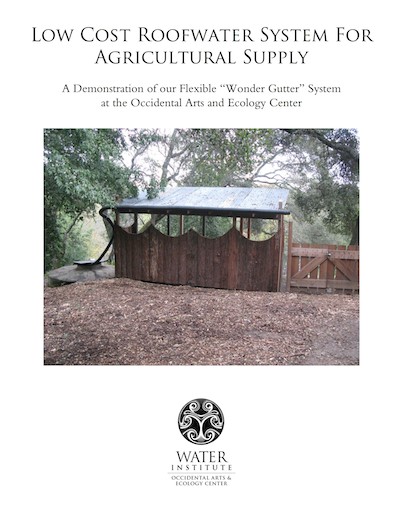

Introduction
Fresh, potable water is a precious and increasingly limited resource for humans, livestock, and the myriad species across the globe that rely on it for life. Those of us fortunate to live in areas with adequate rainfall can take advantage of this by building a low-cost roofwater catchment system to help support our livestock.
By creating on-site water storage to capture and store existing rainfall, one can eliminate the need to draw from precious groundwater supplies and limited instream flows while avoiding the high costs (economic and environmental) of hooking into municipal systems. Livestock benefit from having a clean and reliable water supply. The ecosystem benefits from reduced erosion, flooding, and pollution caused by run-off and the reduction of demand on ground and surface water supplies.
Occidental Arts and Ecology Center’s WATER Institute explores these kinds of strategies and, through demonstration and education, works to inspire others to do the same.
The following report details the components and illustrates the highlights of a simple roofwater catchment system installed on the roof of a goat shelter. Additionally, steps to consider in designing your own system are included. This particular design is one of many styles of catchment systems that exist around the world, and we encourage you to explore the resources listed at the end of this report to learn more.
The Wonder Gutter Roofwater System
The shed pictured on the previous page was built to cover the feeding area for a small herd of goats. Many reclaimed materials were used, including the corrugated roofing. This type of roofing lends itself well to the kind of low-cost conveyance system we like to use to move the rainwater from the roof to the tank, the “Wonder Gutter.”
This gutter system was designed by WATER Institute staff nearly 20 years ago and has been proven effective in numerous applications. The Wonder Gutter system utilizes widely available and inexpensive components to capture and convey water away from the roof to the storage tank. By simply using a section of solid flexible drainpipe, some small-gauge wire, and a recycled onion sack, this Wonder Gutter provides you with a rainwater harvesting system that doesn’t require expensive pre-filters, fittings, or other specialized components. This system serves three functions: it pre-filters large debris on the roof, carries water from the roof to the tank, and performs a final filtration at the end as the water passes through the simple onion sack before entering the tank. We have dubbed it the Wonder Gutter because it makes us wonder why we didn’t think of this sooner!
![IMG_6860[1]](https://oaec.org/wp-content/uploads/2014/09/IMG-68601.jpg)
To make the Wonder Gutter, we cut a piece of flexible HDPE corrugated drain pipe (3” diameter) to fit the length of the roof, plus a four-inch overhang on the right side plus the length needed to reach the tank and hang down inside. We then slit the side of the drainpipe on the seam (see photo below) and slid it over the bottom edge of the roofing. It is important to follow the seam when cutting, as this will ensure a straight cut. We secured the gutter by drilling a hole in the roofing and running a thin-gauge wire through this hole and around the outside of the pipe at two-foot intervals. Any scrap wire, poly baling twine, or plastic zip ties could be used for this. Leave the first four inches of pipe on the uphill (non-tank) side of the gutter intact, as this will give you space to add an end cap. As far as we can tell, this gutter design can only be used on metal roofing as it requires a thin, rigid overhanging edge to attach the “gutter” to.
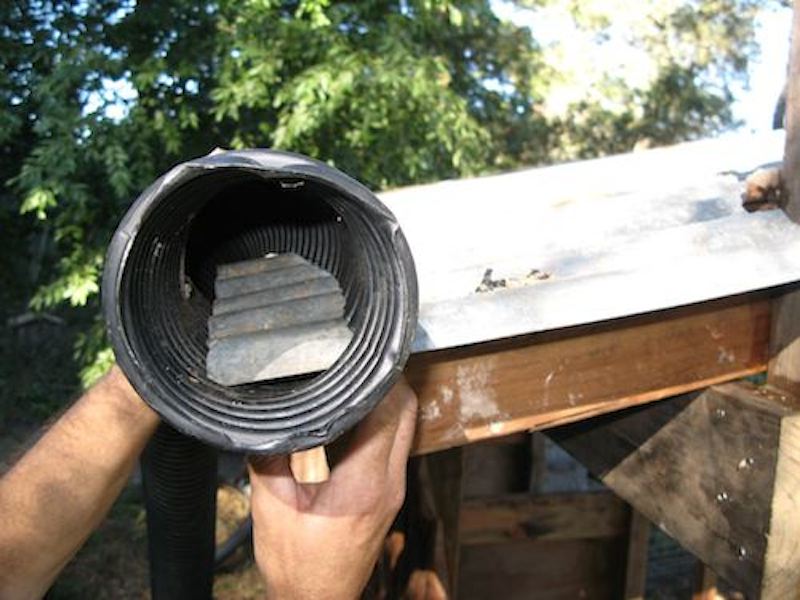
In the photo below, you can see the cross-section of the pipe over the edge of the roofing. We made sure to let the roofing overhang about 3-5” to allow space for the drainpipe to slide over the edge. Here you can see how we left the first four inches uncut to allow for a cap to be placed on this end.
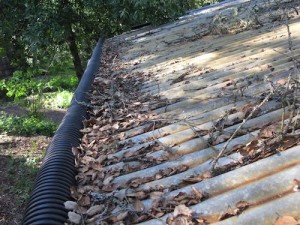
This roof is located under trees, and so collects leaves and other debris. With this type of gutter system, very few, if any, of the leaves enter the pipe, which eliminates the need for a gutter guard. It is important to note that with this system located under oak trees, less rainfall reaches the catchment area, reducing quantity, and the tannins introduced by the leaves can affect water quality. One must clear the roof annually of all accumulated debris, both to improve water quality and reduce fire danger. For these reasons, it is better to site it away from the trees if given the choice.
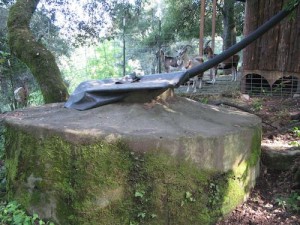
The drainpipe comes off the roof and enters the top of this cistern. We were fortunate enough to have an existing 1200-gallon ferro-cement tank situated near our barn that was no longer being used. Farallones Institute staff constructed this tank in the 1970s as part of their Peace Corps staff training, and it is still functional today, with no additional repairs needed. The top of the cistern is below the lowest part of the roofline, which allows the water to be gravity-fed into the storage tank, eliminating the need for costly pumps. This makes it ideal for remote locations that have no source of electricity to power the pump. We wrapped a scrap of pond liner around the incoming pipe and around the lid to keep it all in place. This seals the lid to prevent mosquitoes from entering and breeding in the tank.
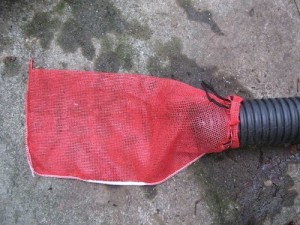
To prevent any debris from getting into the tank, we wired this reused plastic onion sack onto the end of the pipe. After three winters of operation, we found no more than 25 leaves in this filter. This is a low-cost solution that reuses an existing resource (onion sack) that might otherwise be tossed into the landfill.
The goat shed roof has a catchment area of roughly 160 square feet. For every inch of rain that falls, the roof delivers roughly 100 gallons of water to the 1200-gallon tank. See our section on “Collection Capacity” below to learn how to calculate the collection capacity of your roof.

The cistern is plumbed to the chicken’s automatic water system in our coop down the hill, which is gravity fed by the stored roofwater year-round. These refilling water troughs with float valves can be purchased at any feed store or agricultural fencing supplier.
General System Design Considerations
(Excerpted from Conservation Strategy No. 5: Roofwater Harvesting for Coastal California Communities, written by Brock Dolman, Kate Lundquist, and Kevin Swift – available for download)
Conservation
A roofwater harvesting system is not intended as supply augmentation to permit continued inefficiency, waste, or growth in demand. Roofwater harvesting is a way to seasonally offset demand for instream flows and groundwater with stored rainwater. In any water system design, conservation and efficiency are always the first steps. The following websites offer strategies that can significantly reduce a site’s water use. For residential conservation, see www.h2ouse.org. Agricultural users visit www.pacinst.org.
Regulations and Permitting
Before starting a design, research existing policies or ordinances in your area that regulate the use of rainwater, and be sure your intended system will comply. In many counties, tanks over 5,000 gallons will need a building permit for their grading and installation. For more information visit your county’s building department website.
Intended Use: Potable or Non-potable
Anyone whose current water system is specifically affected by the dry season or who uses water from a stream will benefit from installing a roofwater system. The appropriate kind of system will depend on the intended use of the stored water.
Simple non-potable systems provide fire protection, irrigation, and livestock water supply independent of instream flows and groundwater. Potable systems need filtration, treatment, and possibly a backflow preventer, but add potable water security. Consider these factors to determine which roofwater system is most appropriate:
- If irrigation or livestock water supplies are insufficient or unusable, or there are water needs in remote/inaccessible areas (even those currently served by stream diversion or pumping), then consider a non-potable system.
- If the current potable water supply requires trucking, there is seasonal diminished well capacity or unreliability, or there are concerns about water quality, then the higher cost of a potable water system may be justified.
Site Survey and Water Audit
To determine how much water will be needed during the summer, perform a water audit on the structures and surrounding landscape. A Residential Self-Survey Conservation Strategy will help in estimating storage capacity needed for 3 rainless months. For help performing a water audit and designing systems for larger-scale agricultural needs, contact Gold Ridge Resource Conservation District.
Elements of a Non-Potable Roofwater System
Roofwater harvesting systems range in complexity from rain barrels under downspouts to fully engineered municipal-scale systems. All share the following elements.
Collection Capacity
To calculate the collection area of a structure’s roof, measure the horizontal length and width of your roof line (not the sloped roof) and multiply them to calculate the total square footage. Next, gather data on average annual rainfall for the area. On-site rain gauge data is optimal, but contacting the local weather service, agricultural extension agent, or public water agency will suffice.
Now estimate the water quantity the structure’s roof could harvest per year using the following formula: (Collection area square footage) x (Average annual inches of rainfall) x (600 gallons) / 1000) = Total gallons of rainfall harvested per year.
While average annual rainfall numbers are a good starting point, it is a valuable exercise to do this calculation for 25- and 50-year drought figures in order to plan for the worst-case scenario you can use a capacity calculator.
Gutters and downspouts
24-hour storm intensity in the area will determine gutter and downspout size. Ideally, gutters should capture all the rain that falls during a storm without overflowing. In most coastal communities, a 6″ gutter system will work for all but the most severe storms.
Storage capacity
In medium to large systems, storage will be the largest expense and take the most space, and so needs to be carefully selected and sized. Based on your water audit, include storage for at least a three-month supply. Bear in mind, this is a minimum number—current projections are for worsening droughts and increasingly erratic climatic conditions. Increasingly, municipalities are offering incentives to offset part of the installation cost for roofwater harvesting systems. For additional information on storage options, see Water Storage: Tanks, Cisterns, Aquifers and Ponds by Art Ludwig.
Overflow
Once the storage structure is full, the overflow water needs to be piped to an appropriate stormwater management location like a rain garden or bio-swale. For help with designing an overflow system, please read the Storm Water Conservation Strategy.
Site Design
Storage structure placement design parameters are complex and beyond the scope of this document. At a minimum, the location must be solid, seismically stable, and provide sufficient clearance below your lowest gutter to install the first-flush pre-filter and/or roof washer above the top of the installed tank. For underground installations, be sure to assess the water table before designing the site.
Deciding Who Will Build The System
As with any building project, it is important to ensure that your design is safe. Water is VERY heavy (over 8,000 pounds for a full thousand-gallon tank), and it is worthwhile to pay professionals to review your plans, even if you are building it yourself.
Large roof area and open spaces can make agricultural installations less prone to restrictions on tank size and siting, while offering much improved water security for crops and animals during drought years. In upland dry sites distant from existing plumbed infrastructure, consider placing a freestanding, self-filling tank. If additional capacity is needed, simple shed roofs built over roofwater storage structures can reduce demand for stream and groundwater. These tanks may be viable when the stocking rate and duration of use are proportionate to the collection and storage capacity of the structure.
In conclusion, in three years of use with nearly a total of 200 inches of rain, there have been no problems with this system. We hope that this example will inspire you to consider installing a roofwater catchment system before buying water for your livestock or using precious water from your municipal supplier, well, or nearby waterway. To learn more, review the resources below or consider taking a course at the Occidental Arts and Ecology Center.





